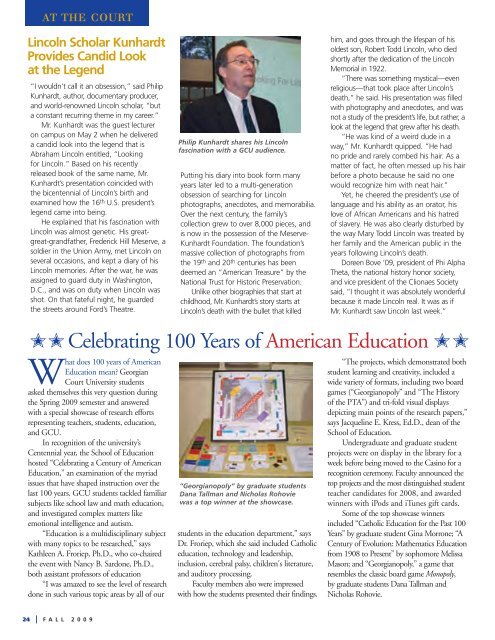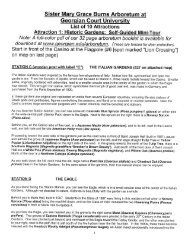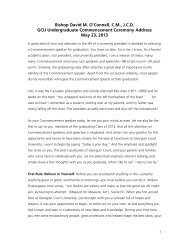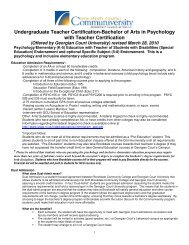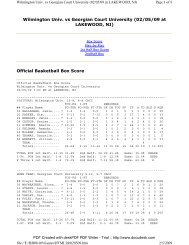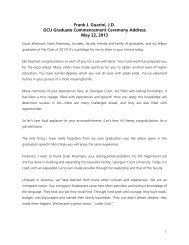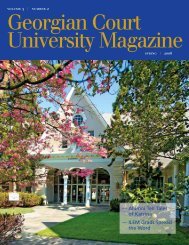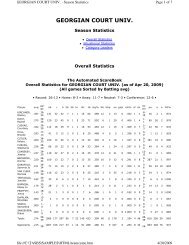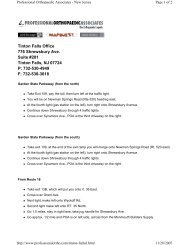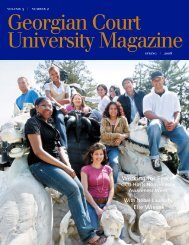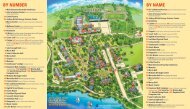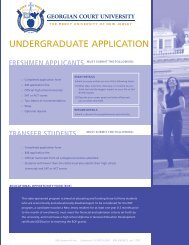Georgian Court University Magazine
Georgian Court University Magazine
Georgian Court University Magazine
You also want an ePaper? Increase the reach of your titles
YUMPU automatically turns print PDFs into web optimized ePapers that Google loves.
at the court<br />
Lincoln Scholar Kunhardt<br />
Provides Candid Look<br />
at the Legend<br />
“I wouldn’t call it an obsession,” said Philip<br />
Kunhardt, author, documentary producer,<br />
and world-renowned Lincoln scholar, “but<br />
a constant recurring theme in my career.”<br />
Mr. Kunhardt was the guest lecturer<br />
on campus on May 2 when he delivered<br />
a candid look into the legend that is<br />
Abraham Lincoln entitled, “Looking<br />
for Lincoln.” Based on his recently<br />
released book of the same name, Mr.<br />
Kunhardt’s presentation coincided with<br />
the bicentennial of Lincoln’s birth and<br />
examined how the 16 th U.S. president’s<br />
legend came into being.<br />
He explained that his fascination with<br />
Lincoln was almost genetic. His greatgreat-grandfather,<br />
Frederick Hill Meserve, a<br />
soldier in the Union Army, met Lincoln on<br />
several occasions, and kept a diary of his<br />
Lincoln memories. After the war, he was<br />
assigned to guard duty in Washington,<br />
D.C., and was on duty when Lincoln was<br />
shot. On that fateful night, he guarded<br />
the streets around Ford’s Theatre.<br />
Philip Kunhardt shares his Lincoln<br />
fascination with a GCU audience.<br />
Putting his diary into book form many<br />
years later led to a multi-generation<br />
obsession of searching for Lincoln<br />
photographs, anecdotes, and memorabilia.<br />
Over the next century, the family’s<br />
collection grew to over 8,000 pieces, and<br />
is now in the possession of the Meserve-<br />
Kunhardt Foundation. The foundation’s<br />
massive collection of photographs from<br />
the 19 th and 20 th centuries has been<br />
deemed an “American Treasure” by the<br />
National Trust for Historic Preservation.<br />
Unlike other biographies that start at<br />
childhood, Mr. Kunhardt’s story starts at<br />
Lincoln’s death with the bullet that killed<br />
him, and goes through the lifespan of his<br />
oldest son, Robert Todd Lincoln, who died<br />
shortly after the dedication of the Lincoln<br />
Memorial in 1922.<br />
“There was something mystical—even<br />
religious—that took place after Lincoln’s<br />
death,” he said. His presentation was filled<br />
with photography and anecdotes, and was<br />
not a study of the president’s life, but rather, a<br />
look at the legend that grew after his death.<br />
“He was kind of a weird dude in a<br />
way,” Mr. Kunhardt quipped. “He had<br />
no pride and rarely combed his hair. As a<br />
matter of fact, he often messed up his hair<br />
before a photo because he said no one<br />
would recognize him with neat hair.”<br />
Yet, he cheered the president’s use of<br />
language and his ability as an orator, his<br />
love of African Americans and his hatred<br />
of slavery. He was also clearly disturbed by<br />
the way Mary Todd Lincoln was treated by<br />
her family and the American public in the<br />
years following Lincoln’s death.<br />
Doreen Bove ’09, president of Phi Alpha<br />
Theta, the national history honor society,<br />
and vice president of the Clionaes Society<br />
said, “I thought it was absolutely wonderful<br />
because it made Lincoln real. It was as if<br />
Mr. Kunhardt saw Lincoln last week.”<br />
✭ ✭ Celebrating 100 Years of American Education ✭ ✭<br />
What does 100 years of American<br />
Education mean? <strong>Georgian</strong><br />
<strong>Court</strong> <strong>University</strong> students<br />
asked themselves this very question during<br />
the Spring 2009 semester and answered<br />
with a special showcase of research efforts<br />
representing teachers, students, education,<br />
and GCU.<br />
In recognition of the university’s<br />
Centennial year, the School of Education<br />
hosted “Celebrating a Century of American<br />
Education,” an examination of the myriad<br />
issues that have shaped instruction over the<br />
last 100 years. GCU students tackled familiar<br />
subjects like school law and math education,<br />
and investigated complex matters like<br />
emotional intelligence and autism.<br />
“Education is a multidisciplinary subject<br />
with many topics to be researched,” says<br />
Kathleen A. Froriep, Ph.D., who co-chaired<br />
the event with Nancy B. Sardone, Ph.D.,<br />
both assistant professors of education<br />
“I was amazed to see the level of research<br />
done in such various topic areas by all of our<br />
”<strong>Georgian</strong>opoly” by graduate students<br />
Dana Tallman and Nicholas Rohovie<br />
was a top winner at the showcase.<br />
students in the education department,” says<br />
Dr. Froriep, which she said included Catholic<br />
education, technology and leadership,<br />
inclusion, cerebral palsy, children's literature,<br />
and auditory processing.<br />
Faculty members also were impressed<br />
with how the students presented their findings.<br />
“The projects, which demonstrated both<br />
student learning and creativity, included a<br />
wide variety of formats, including two board<br />
games (“<strong>Georgian</strong>opoly” and “The History<br />
of the PTA”) and tri-fold visual displays<br />
depicting main points of the research papers,”<br />
says Jacqueline E. Kress, Ed.D., dean of the<br />
School of Education.<br />
Undergraduate and graduate student<br />
projects were on display in the library for a<br />
week before being moved to the Casino for a<br />
recognition ceremony. Faculty announced the<br />
top projects and the most distinguished student<br />
teacher candidates for 2008, and awarded<br />
winners with iPods and iTunes gift cards.<br />
Some of the top showcase winners<br />
included “Catholic Education for the Past 100<br />
Years” by graduate student Gina Morrone; “A<br />
Century of Evolution: Mathematics Education<br />
from 1908 to Present” by sophomore Melissa<br />
Mason; and “<strong>Georgian</strong>opoly,” a game that<br />
resembles the classic board game Monopoly,<br />
by graduate students Dana Tallman and<br />
Nicholas Rohovie.<br />
24 | FALL 2009


